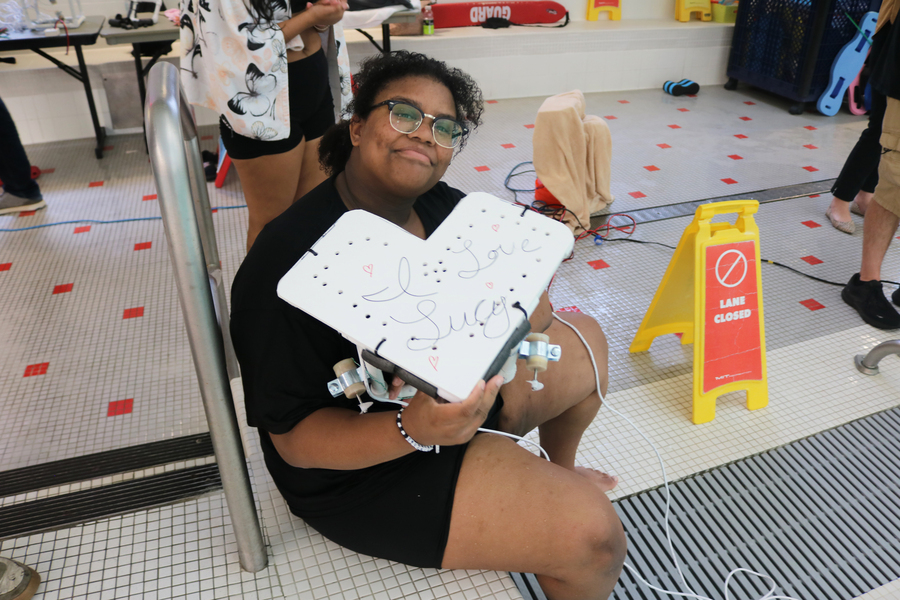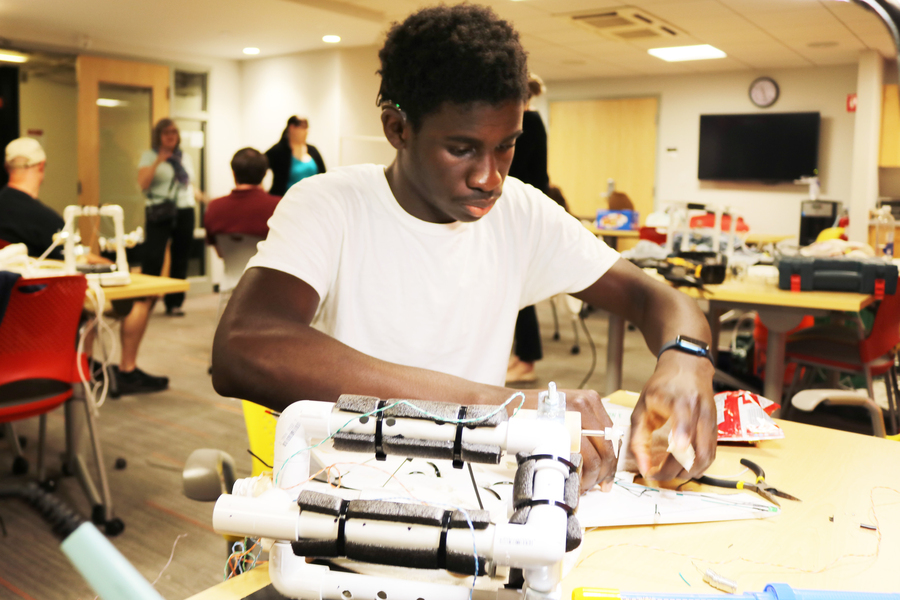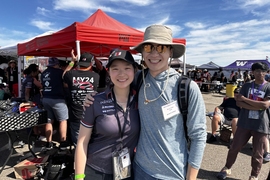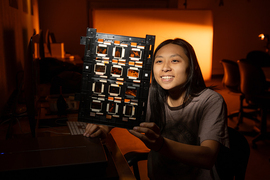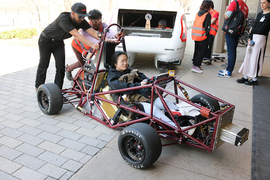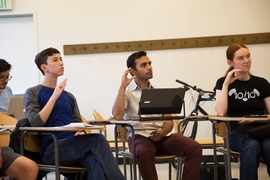The percentage of deaf and hard-of-hearing individuals who have bachelor’s degrees is 15.2 percent lower than their hearing counterparts, and for those who do have degrees, most are in business and education. Deaf adults with degrees in STEM fields are few and far between. MIT Edgerton Center instructor Amanda Gruhl Mayer ’99, PhD ’08 has set out to bridge this gap by piloting a new MIT workshop called STEAMED (Science, Technology, Engineering, Art, and Math Experience for Deaf and hard-of-hearing students).
The workshop tasked students with building an underwater remotely operated vehicle (ROV), teaching them new skills to build circuits, motors, and frames. At the end of the course, students tested their robots at the Z Center pool. Gruhl Mayer worked with Brian Gibson, a science teacher at Horace Mann School for the Deaf and Hard of Hearing; Edgerton Center instructors Chris Mayer and Christian Cardozo ’18; and MIT student mentors rising senior Ryn Moore and Ruben Castro ’24. With several instructors and mentors at varying levels of American Sign Language (ASL) fluency, ASL interpreters strengthened communication between all participants.
Gruhl Mayer became interested in Deaf education when she moved into her first house in 2020 and met her neighbor’s deaf 13-year-old daughter, who was interested in science. Gruhl Mayer wanted to encourage her to delve deeper into STEM subjects. As she learned ASL, Gruhl Mayer quickly discovered that important scientific terms, like “amino acid,” “acceleration,” and “circuit,” lack common signs in ASL because there aren’t enough deaf scientists and engineers for the vocabulary to develop naturally. While pursuing a master’s degree in Deaf education at Boston University, she deepened her passion for Deaf culture. “I really want to push the pipeline for more deaf scientists and engineers. And I think we need to start with students,” Gruhl Mayer says.
Gruhl Mayer’s students entered the course not knowing exactly what they would be building, and quickly learned how to construct their own ROVs using SeaPerch kits from the MIT Sea Grant program. The ROV project is a favorite at the Edgerton Center for introducing high school students to power tools and circuits, and this is the first time it was presented to deaf students. During the workshop, the students and interpreters developed signs to use for new skills and concepts, like “soldering” and “buoyancy.”
Students waterproofed their motors, built thrusters, and connected them to controllers. They used power tools to create PVC pipe frames with attached foam core to make them neutrally buoyant, then tested the movement of their ROVs in a small tank inside the classroom. Students modified their designs to create unique ROVs, decorating them using lights and colored markers, and took them for a test drive in the Z Center Pool. Students picked up skills quickly and taught each other as they learned, each designing a unique ROV that could move in all directions, navigate through obstacles, and even pick something up off the bottom of the pool.
Brian Gibson, who’s been teaching hands-on science at Horace Mann for 21 years, says, “I’ve enjoyed watching the students become more independent and using different materials and tools that they haven't used in the past and become pretty proficient with those tools.” The students also enjoyed the increased responsibility. “Typically, we’re not allowed to use certain tools. They don’t offer us much responsibility. And so now, we were able to see how the tools work. I think that opens new opportunities for us,” says Bárbara Silva, a rising junior at the Horace Mann School. Students also appreciated the freedom and creativity that comes with not being graded. “At school, at home, or anywhere, things have to be perfect. But here, you could fail, and then you learn something new,” says rising junior at Newton North High School Lucy Howard-Karp.
Among the takeaways for the Edgerton Center instructors is recognizing the unique challenge of having to use your hands for communication while concurrently building. For example, hearing teachers often said “good job” to students while they were working, which made the students stop their work to watch the interpreter. Students requested that teachers wait for a good stopping point to give them praise, and only interrupt if the students are doing something that needs to be corrected. Gruhl Mayer points out, “Deaf students are just like hearing students. They have the same potential, enthusiasm, work ethic, etc. But there are educational tweaks that need to be made for deaf students, to help them learn in the way that’s best for them.”
Gruhl Mayer’s vision to make STEM accessible for deaf students has the potential to drive discoveries in the science community. “The term is called 'Deaf gain,'” she explains. “Deaf people see the world differently, which gives them a new and fresh perspective. This unique viewpoint drives their creativity and innovation. So many amazing discoveries have been made by deaf scientists and engineers.”
Gruhl Mayer plans to run the workshop again next summer with more participants, hopefully having this year’s students come back as mentors. The students plan to get their fellow classmates excited to sign up by bringing their ROVs to school and showing off what they built.


